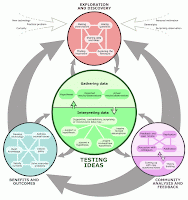 |
| Image credit: Morgue File |
One of the unique aspects of the science classroom is safety. A good science teacher prioritizes and actively models safe behavior for her or his students at all times. To do otherwise is negligent.
Before every lab activity, students and I spend time reviewing the safety considerations and expectations, no matter how minor or seemingly trivial. Behind the scenes, I am checking, maintaining, and calibrating science equipment before and after labs, conducting annual chemical inventories and chemical storage reviews, and keeping up-to-date on science safety news and information. The last thing I want in my classroom is an accident caused by unsafe behavior; therefore, safety is always our #1 priority.
Before every lab activity, students and I spend time reviewing the safety considerations and expectations, no matter how minor or seemingly trivial. Behind the scenes, I am checking, maintaining, and calibrating science equipment before and after labs, conducting annual chemical inventories and chemical storage reviews, and keeping up-to-date on science safety news and information. The last thing I want in my classroom is an accident caused by unsafe behavior; therefore, safety is always our #1 priority.
Flinn Scientific is a great resource for science classroom safety, as well as being a wonderful source for science materials and equipment. They offer a wide range of free science safety resources including training videos, printable MSDS documents, chemical storage guidelines, safety contracts, and more. Whether you are a brand new or veteran science teacher, the safety resources from Flinn are worthy of your time.
For years now, we have been using Flinn's Science Safety Contract in our school. Offered in both English and Spanish, this contract is comprehensive, logical, and easy-to-understand for middle schoolers. All students and parents must sign this contract before being permitted to participate in any science lab activities.
In addition to getting familiar with the safety contract, I have students create a safety diagram of the science classroom. This activity gives students the chance to locate every safety feature in and near the science classroom, thus giving them ownership for our collective safety. We brainstorm and discuss the purpose and operation of each safety feature, and demonstrate a few of the items along the way. To be considered excellent, students' safety diagrams must be clearly labelled, be simple enough for any child in our K-8 school to use, and include standard diagram elements such as a descriptive title, a masterpiece caption, a key, a compass rose, and appropriate colors to distinguish items.
My commitment to science safety is captured quite pointedly on a poster I have in my classroom. In stark black and white, the poster shows the silhouette of a young woman using a blind walking cane. The caption reads, "Carol never wore her safety goggles. Now she doesn't need them." The message to students is crystal clear…




